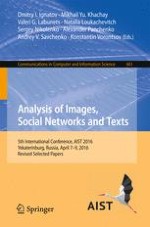2017 | Buch
Analysis of Images, Social Networks and Texts
5th International Conference, AIST 2016, Yekaterinburg, Russia, April 7-9, 2016, Revised Selected Papers
herausgegeben von: Dmitry I. Ignatov, Mikhail Yu. Khachay, Valeri G. Labunets, Natalia Loukachevitch, Sergey I. Nikolenko, Alexander Panchenko, Andrey V. Savchenko, Konstantin Vorontsov
Verlag: Springer International Publishing
Buchreihe : Communications in Computer and Information Science
